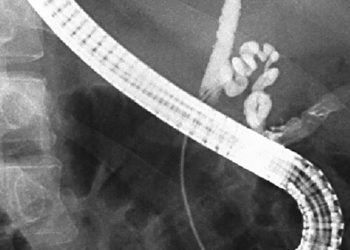Obesogenic infant feeding behaviors prevalent in 2-month-old infants
Image: PD/CDC/ Debora Cartagena
1. In 2-month-old infants, a high prevalence of feeding and activity behaviors thought to be associated with childhood obesity was found across all race/ethnic subgroups, though higher rates of certain behaviors were noted in Hispanic or black subgroups when compared to the white subgroup.
2. Ninety percent of 2-month-old infants had an average daily television exposure of 346 mins/day, with the black subgroup reporting mean television exposure of 546 mins/day.
Evidence Rating Level: 2 (Good)
Study Rundown: Recent studies have shown that more than a quarter of United States toddlers are overweight or obese, lending further support to early childhood interventions. A majority of these interventional efforts target feeding- and activity-related behaviors involving young children and their caregivers. Feeding behaviors thought to be “obesogenic” include early introduction to formula feeding or solid foods, putting infants to bed with bottles, propping bottles during feeding, feeding infants every time they cry, and encouraging infants to finish bottles. Obesogenic activity behaviors include television exposure and not meeting “tummy time” recommendations. This study specifically looked at these feeding and activity behaviors in infants at 2 months of age in a predominantly low-income population and found that all behaviors were highly prevalent. Discrepancies between race/ethnicity groups were noted in all behaviors after adjustment for parental age and socioeconomic status. Limitations to this study include self-report measures, an inability to thoroughly capture confounding factors that may impact parental behavior, and the comparison of obesogenic behaviors between groups with baseline elevations in obesity rates. Regardless, this study suggests a need for stronger early interventions to target childhood obesity, with specific efforts geared toward addressing cultural differences.
Click to read the study published today in Pediatrics
Relevant Reading: The first few months of life: a critical period for development of obesity
Study Author, Dr. Eliana M. Perrin, MD, MPH, talks to 2 Minute Medicine: Department of Pediatrics, School of Medicine, and Cecil G. Sheps Center for Health Services Research, University of North Carolina – Chapel Hill.
“These results from a large and diverse population of infants—especially the high rates of television watching– teach us that we must begin obesity prevention even earlier. I like to tell parents, “Allow your babies to play and begin to prop themselves up in a safe space. Try not to have them watch television. Try to notice whether they are showing you they are hungry or full.”
Rather than focus on the ethnic and racial differences, our research teaches us that we can all do better. Families of all races and ethnicities need early counseling to lead healthier lives. What the differences show us is that counseling should be probably be culturally-tailored since parents of different backgrounds may feed and play with their children differently. We are hoping our research sheds light on the best ways to do that.”
In-Depth [cross-sectional study]: This cross-sectional study looked at self-reported behaviors from 863 parents of 2 month-old-infants; enrollees in this study were part of a larger randomized control trial of obesity prevention at 4 health centers. Race and ethnicity were measured together as a variable, with Hispanic, white non-Hispanic, black non-Hispanic, and other non-Hispanic categories. Discrepancies between race/ethnic groups were calculated by comparing black and Hispanic subgroups to the white subgroup, with adjustments made for parental age and socioeconomic status. Fifty percent of enrollees identified as Hispanic, 27% black ,and 18% white. Additionally, 86% of enrollees qualified for Medicaid.
All measured feeding-related behaviors were highly prevalent across race/ethnic groups: exclusive formula feeding (45%), early introduction of solid foods (12%), putting infants to bed with bottles (43%), propping bottles during feeding (23%), feeding infants every time they cry (20%), encouraging infants to finish bottles (38%). Hispanic parents had higher rates of encouraging infants to finish bottles (adjusted odds ratio (aOR) = 1.93, P = 0.007), while black parents had higher rates of putting infants to bed with bottles (aOR = 1.97, P = 0.004) when compared to the white subgroup. Both Hispanic and black groups reported higher rates of bottle propping (Hispanic aOR = 2.47, P = 0.009, black aOR = 3.05, P < 0.001). Approximately 90% of infants had daily television exposure (mean: 346 mins/day, active watching: 25 mins/day), with the black subgroup reporting mean television exposure time as 546 mins/day, with 51 mins/day of active watching. Only 34% of all parents met the American Academy of Pediatrics recommended “tummy time” duration of 30 mins/day.
More from this author: Childhood immunizations cost-effective and linked to reduced disease burden, Clinical practice guidelines linked to improved bronchiolitis outcomes, Dexamethasone shows comparable efficacy to prednisone/prednisolone in pediatric asthma, Cardiovascular events in Kawasaki disease not significantly increased over controls, Hypotonic IVF linked to increased risk of hyponatremia
©2012-2014 2minutemedicine.com. All rights reserved. No works may be reproduced without expressed written consent from 2minutemedicine.com. Disclaimer: We present factual information directly from peer reviewed medical journals. No post should be construed as medical advice and is not intended as such by the authors, editors, staff or by 2minutemedicine.com. PLEASE SEE A HEALTHCARE PROVIDER IN YOUR AREA IF YOU SEEK MEDICAL ADVICE OF ANY SORT.







